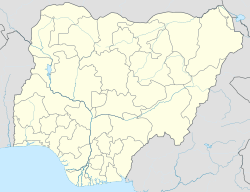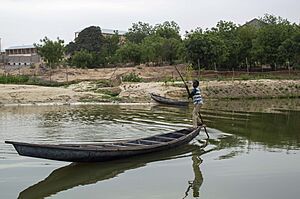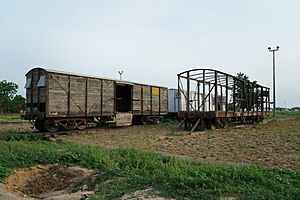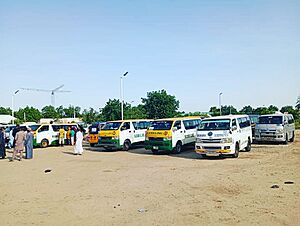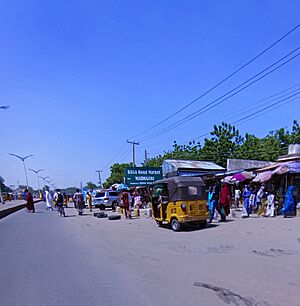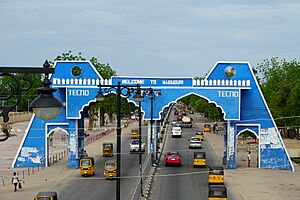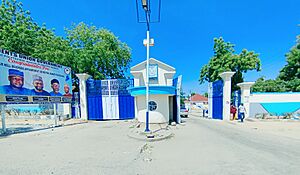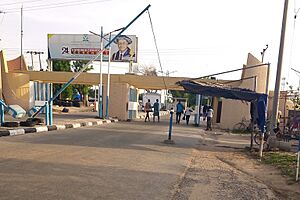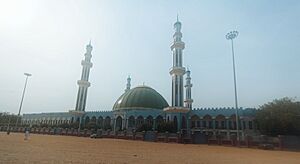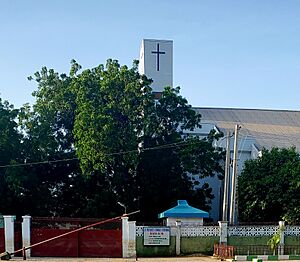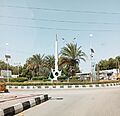Maiduguri facts for kids
Quick facts for kids
Maiduguri
Yerwa
|
|
|---|---|
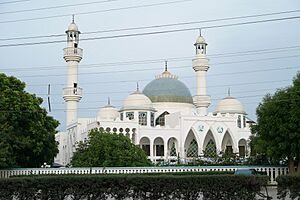
The Indimi Mosque situated in Maiduguri
|
|
| Country | |
| State | Borno |
| Area | |
| • Total | 105.5 km2 (40.7 sq mi) |
| Elevation | 320 m (1,050 ft) |
| Population
(2022 projection)
|
|
| • Total | 791,200 |
| • Density | 7,500/km2 (19,424/sq mi) |
| GDP (PPP, 2015 int. Dollar) | |
| • Year | 2023 |
| • Total | $6 billion |
| • Per capita | $7,100 |
| Climate | BSh |
Maiduguri is the capital and largest city of Borno State in north-eastern Nigeria. This important city is located on the continent of Africa. It sits along the seasonal Ngadda River, which flows into the Firki swamps near Lake Chad.
The city of Maiduguri was started in 1907. It was first a military base built by the British Empire during the time when Nigeria was a colony. In 2022, it was estimated that about two million people live in the Maiduguri area.
Contents
History of Maiduguri
Early Beginnings
For many centuries, the area where Maiduguri is located was part of the powerful Kanem–Bornu Empire. Maiduguri is actually made up of two older towns: Yerwa to the west and Old Maiduguri to the east.
Yerwa was founded in 1907 by Abubakar Garbai of Borno. He made it the new capital of the Bornu Kingdom. Before this, Yerwa was just a small village called Kalwa. This move changed the capital for the Kanuri people from Kukawa.
Old Maiduguri was chosen by the British in 1908 to be their main military base. It took the place of Mafoni. In the same year, it became the home for the British Resident Commissioner, who was in charge of British Bornu.
In 1957, Yerwa became the official name for the city center. The name 'Maiduguri' was then used for the surrounding rural areas. In 1964, a railway line was built to Maiduguri. This helped the city grow into a major trading center in the region.
Maiduguri was once known as a place for Islamic learning in West Africa. It taught people about tolerance and being welcoming, much like its many neem trees.
Maiduguri is one of fifteen Local Government Areas (LGAs). These LGAs make up the Borno Emirate, which is a traditional state in Borno State, Nigeria.
Maiduguri's Climate
Maiduguri has a hot semi-arid climate. This means it is generally hot and dry. The city's climate is classified as BSh by the Köppen–Geiger climate classification system.
The highest temperature ever recorded in Maiduguri was 47°C (117°F) on May 28, 1983. The lowest temperature recorded was 5°C (41°F) on December 26, 1979.
When the British ruled the area, they made tree planting a big priority. Large trees along the main roads help provide shade from the strong sun.
Temperature Patterns
The hot season in Maiduguri lasts for about 2.4 months. This is from March 13 to May 26. During this time, the daily high temperature is usually above 39°C (102°F). May is the hottest month of the year. The average high in May is 39°C (103°F), and the average low is 26°C (79°F).
The cooler season lasts for about 2.1 months. This is from July 20 to September 23. During this time, the daily high temperature is usually below 33°C (92°F). January is the coldest month of the year. The average low in January is 15°C (59°F), and the average high is 33°C (92°F).
| Climate data for Maiduguri | |||||||||||||
|---|---|---|---|---|---|---|---|---|---|---|---|---|---|
| Month | Jan | Feb | Mar | Apr | May | Jun | Jul | Aug | Sep | Oct | Nov | Dec | Year |
| Record high °C (°F) | 40 (104) |
42 (108) |
44 (111) |
46 (115) |
47 (117) |
42 (108) |
43 (109) |
36 (97) |
38 (100) |
39 (102) |
39 (102) |
38 (100) |
47 (117) |
| Mean daily maximum °C (°F) | 31.9 (89.4) |
34.6 (94.3) |
37.8 (100.0) |
40.1 (104.2) |
39.4 (102.9) |
36.4 (97.5) |
33.2 (91.8) |
32.0 (89.6) |
33.7 (92.7) |
36.4 (97.5) |
34.2 (93.6) |
32.3 (90.1) |
35.2 (95.4) |
| Daily mean °C (°F) | 21.8 (71.2) |
24.8 (76.6) |
29.3 (84.7) |
32.6 (90.7) |
32.5 (90.5) |
30.2 (86.4) |
27.5 (81.5) |
26.6 (79.9) |
27.2 (81.0) |
27.9 (82.2) |
24.9 (76.8) |
23.2 (73.8) |
27.4 (81.3) |
| Mean daily minimum °C (°F) | 12.6 (54.7) |
15.3 (59.5) |
19.7 (67.5) |
21.9 (71.4) |
25.5 (77.9) |
24.5 (76.1) |
22.9 (73.2) |
22.3 (72.1) |
22.4 (72.3) |
20.7 (69.3) |
16.0 (60.8) |
13.1 (55.6) |
19.9 (67.8) |
| Record low °C (°F) | 8 (46) |
10 (50) |
15 (59) |
12 (54) |
18 (64) |
19 (66) |
20 (68) |
19 (66) |
20 (68) |
15 (59) |
10 (50) |
5 (41) |
5 (41) |
| Average precipitation mm (inches) | 0.0 (0.0) |
0.0 (0.0) |
0.3 (0.01) |
13.0 (0.51) |
30.5 (1.20) |
73.8 (2.91) |
147.1 (5.79) |
193.2 (7.61) |
83.0 (3.27) |
11.1 (0.44) |
0.0 (0.0) |
0.1 (0.00) |
552.1 (21.74) |
| Average precipitation days (≥ 1.0 mm) | 0.0 | 0.0 | 0.5 | 1.6 | 4.0 | 7.0 | 10.7 | 10.7 | 6.8 | 1.4 | 0.0 | 0.0 | 42.7 |
| Average relative humidity (%) (at 15:00 LST) | 15.4 | 11.2 | 12.0 | 17.5 | 28.4 | 38.4 | 55.5 | 63.4 | 54.8 | 30.2 | 19.0 | 19.6 | 30.2 |
| Mean monthly sunshine hours | 266.6 | 249.2 | 257.3 | 237.0 | 263.5 | 249.0 | 217.0 | 204.6 | 225.0 | 285.2 | 282.0 | 275.9 | 3,012.3 |
| Mean daily sunshine hours | 8.6 | 8.9 | 8.3 | 7.9 | 8.5 | 8.3 | 7.0 | 6.6 | 7.5 | 9.2 | 9.4 | 8.9 | 8.3 |
| Source 1: NOAA, Climate Charts (latitude: 11°51'N; longitude: 013°05'E; elevation: 354m, 1161') | |||||||||||||
| Source 2: Voodoo Skies for record temperatures | |||||||||||||
People of Maiduguri
Population and Diversity
In 2007, Maiduguri was estimated to have a population of about 1,907,600 people. The city grew in size by 15.1 square kilometers between 2002 and 2012.
Most of the people living in Maiduguri are Muslim. They belong to various ethnic groups like the Kanuri, Hausa, Shuwa, Bura, Marghi, and Fulani. There are also many Christians living in the city. These include people from southern Nigerian states, such as the Igbo, Ijaw, and Yoruba.
Support for Displaced Persons
In 2019, Maiduguri had 22 camps for internally displaced persons (IDPs). These are people who have had to leave their homes. For example, Shagari camp had 48 families, and Cherubim & Seraphim camp had 65 families. In 2016, the National Youth Service (NYC) in Maiduguri housed 4,800 displaced people. Goni Kachallari camp had 340 families in 2016.
People in these camps speak different languages. These include Fulani, Fulfulde, Gamargu, Hausa, Kanuri, Shuwa Arabic, and Marghi. Many people in the camps can understand simple English messages. Almost everyone can understand messages in Hausa or Kanuri.
Air Quality
Maiduguri experiences some air pollution. This is mainly from tiny dust particles. These particles come from vehicles and other sources. They can be harmful if breathed in.
Getting Around Maiduguri
The city is at the end of a railway line. This line connects Maiduguri with other major Nigerian cities. These cities include Port Harcourt, Enugu, Kafanchan, Kuru, and Bauchi.
Maiduguri is also served by the Maiduguri International Airport. This airport helps people travel by air to and from the city.
Maiduguri's Economy
Maiduguri is the main trading center for north-eastern Nigeria. Its economy mostly relies on services and trade. There is also a small amount of manufacturing.
The city has three markets, including a modern "Monday market." This market is known for its impressive appearance.
Maiduguri has a nice layout with wide, well-kept streets. It also has sidewalks and ditches to manage floods. Electricity comes from the main power grid, solar power, and generators. Land and property values in the city are high. In 2009, Maiduguri was the third most expensive city in Nigeria for buying and renting property. Only Abuja and Lagos were more expensive.
Many trucks wait for days on the edge of the city. They carry goods to Dikwa and then to neighboring Cameroon. However, transporting goods to countries like Chad, Central African Republic, and Sudan has faced challenges.
More people have moved to Maiduguri from rural areas and from neighboring countries like Chad, Niger, and Cameroon. This has led to more poverty and unemployment.
Gathering firewood is a way for new residents to earn money. These are often people who have been displaced from their homes. This also helps with the problem of less food being grown due to climate change. Members of Maiduguri's official Association of Firewood Sellers help with tree replanting efforts.
The World Food Programme and the Nigerian Government also help displaced people. They have set up a system to give cash using mobile phones.
Learning in Maiduguri
The University of Maiduguri was started in 1975. It includes a College of Medical Sciences. Other higher education schools in the city are:
- Borno State University
- Ramat Polytechnic
- College of Agriculture
- College of Education
- Muhammad Goni College of Legal and Islamic Studies
- College of Nursing and Midwifery
- College of Health Technology
- El-kanemi College of Islamic Theology
- Annahada College of Science and Islamic Studies
In 2011, the Future Prowess Islamic School offered free education. It taught both Western and Islamic subjects to orphans and children who needed help.
Places of Worship
Maiduguri has many places of worship. Most of them are Muslim mosques. There are also several Christian churches and temples, including:
- Church of Nigeria (Anglican Communion)
- Church of the Brethren in Nigeria (EYN)
- Presbyterian Church of Nigeria (World Communion of Reformed Churches)
- Nigerian Baptist Convention (Baptist World Alliance)
- Living Faith Church Worldwide
- Redeemed Christian Church of God
- Assemblies of God
- Roman Catholic Diocese of Maiduguri
Sports and Fun
Maiduguri is home to the El-Kanemi Warriors, a football (soccer) team. The city also has an active local football league.
Kyarimi Park is the oldest and largest zoo in Nigeria. Thousands of people visit the zoo every year. The city is also a short drive away from picnic spots at Alo Lake and the Zambiza game reserve.
Images for kids
See also
 In Spanish: Maiduguri para niños
In Spanish: Maiduguri para niños


